Loppers are essential gardening tools for pruning tree branches in the garden or around the yard. It looks like scissors or garden shears but with much longer arms and requires two hands to handle properly.
The handles are purposely made long, typically between 12 inches and 36 inches in length, to give enough leverage to cut thick branches.
Some even come equipped with telescopic handles that can be extended further as long as 2 meters to increase leverage and enable the user to reach higher branches on a taller tree.
Our Top Picks
Table of Contents
Types of Loppers
There are 2 main types of loppers, which are:
Bypass loppers
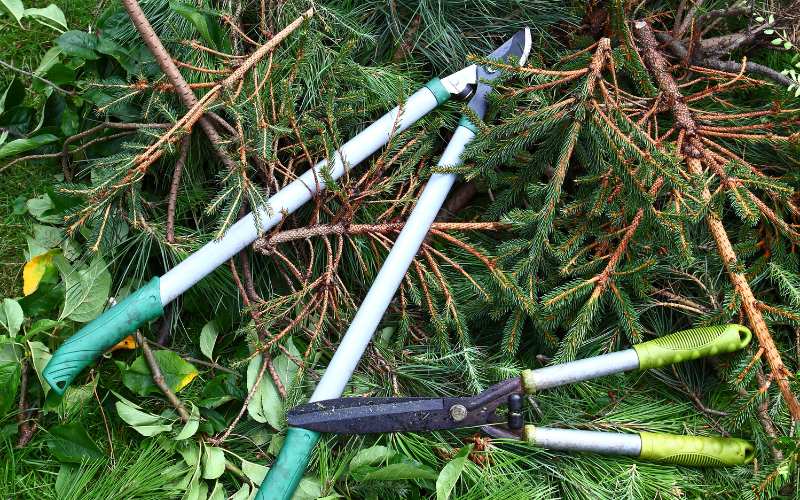
Bypass loppers are very efficient when it comes to pruning tree branches that are 2 inches or less in diameter.
It usually consists of a scissors-like cutting tool with one sharp edge that moves past a rather blunt jaw or hook, which is meant for holding the tree branch while the sharp edge cuts through it.
The scissors-like jaws come in different designs. It might be straight, curved, or one blade curved and the other straight.
Newer or modern designs of bypass loppers are usually equipped with lever systems or gears that help to increase the force applied to the blade to allow it cut through thicker branches efficiently.
Some bypass loppers are also fitted with telescoping arms which makes it possible to reach tall branches with ease.
Anvil Loppers
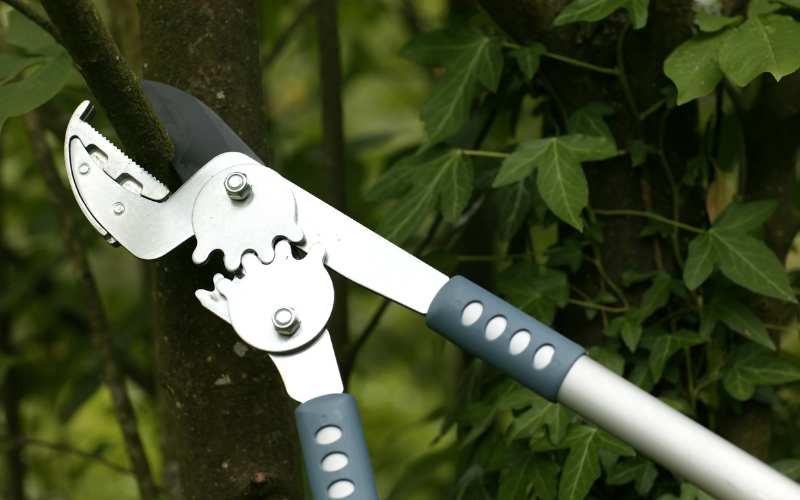
Anvil loppers have two jaws that don’t slide past each other like the blades of scissors but rather close against each other like an anvil.
One of the jaws (straight or curved) is usually made of hardened carbon steel and sharpened to make the cut, while the other jaw is shaped flat like an anvil, and it’s usually made of a softer metal than the sharp jaw or blade. The sharp jaw closes against the contoured anvil surface of the other jaw to make the cut.
Because anvil loppers have one jaw shaped flat like an anvil, they have the disadvantage of tending to crush the branch instead of cutting it smoothly if the cutting jaw is not sharp enough.
However, they’re ideal for cutting thicker, harder, and more fibrous branches as they have more relative strength than bypass loppers, and it’s also less likely for a branch to deflect the jaws or slide in and jam in between the jaws.
If you’re looking to get a bypass or anvil lopper for your tree pruning projects, here are 10 of the best units to choose from.
What To Consider When Choosing A Lopper
If you want to choose the right lopper for your tree pruning projects, it’s important that you consider the following factors.
Cut Capacity
The first factor you need to consider when choosing a lopper is the cut capacity of the lopper. You need to consider the diameter of the tree branches you will be pruning, and ensure the lopper you choose can handle that kind of capacity.
Gearing Mechanism
The gearing mechanism of a lopper provides you an additional leverage and cutting power which makes it easier to cut through thicker branches while exerting less effort.
Some loppers have it, while others don’t. There are 2 main types of gearing mechanisms you’ll find, which are compound action and ratchet mechanism.
Compound Action Gearing
With compound action gearing, the lopper has an additional pivot point or fulcrum close to the blade that allows the handles to open wider than the blade distance, thus increasing your leverage and making it easier to cut through thicker branches.
Ratchet Gearing
With a ratchet gearing, the lopper locks and releases in stages as you apply pressure to the handles. Each time you squeeze or pull the handles together, the ratchet engages and prevents the blade from coming apart.
It allows you to continue cutting the branches in small incremental stages while locking the blade in place, preventing it from opening wider until the cut is complete.
Both the compound action and ratcheting system are designed to help you cut through branches that are at the upper limit of the lopper’s cut capacity. It helps reduce the effort you need to apply to cut through thick branches that are at the highest capacity of the tool.
The only disadvantage of this gearing mechanism is that it makes the lopper heavier, and a bit more expensive than ones without gearing.
Handle Length and Material
Longer handles provides more leverage, making it easier to cut through branches, but they may make the lopper heavier depending on the type of material used to make the handle.
The handles are commonly made from different types of materials like wood, fiberglass and aluminum.
Wooden handles can be heavier and less durable, but are more comfortable to grip. Aluminum and fiberglass handles are stronger, more durable and lightweight.
Blade Material
One of the most important things to consider when choosing a lopper is the material used to make the cutting blade.
The blades can be made from high-carbon steel, hardened steel and stainless steel. High carbon steel blades can maintain their edge for long periods of time but not as much as hardened steel blades. They’re however, easier to sharpen compared to hardened steel.
Both high-carbon carbon and hardened steel blades are not resistant to rust and corrosion, but they can be coated with non-stick material to help them resist corrosion, and prevent sap and other materials from sticking to the blade during use.
Loppers with stainless steel blades are rust and corrosion resistant, but they’re slightly less durable than high-carbon and hardened steel blades.
The Blade Type
You’ll also have to consider choosing between a bypass blade or an anvil blade. Bypass blades are more versatile and produces a cleaner cut, which makes them suitable for pruning live branches.
Anvil blades on the other hand can crush and split branches, which may make it more challenging for the tree to heal and potentially increase the risk of the branch getting infected. They’re however better suited for handling thicker branches. They can cut branches up to 2 inches in diameter and more.
The 6 Best Loppers
After thorough research, testing and feedback from our users, here’s the 6 best loppers we recommend.
1. Fiskars PowerGear2 Bypass Loppers
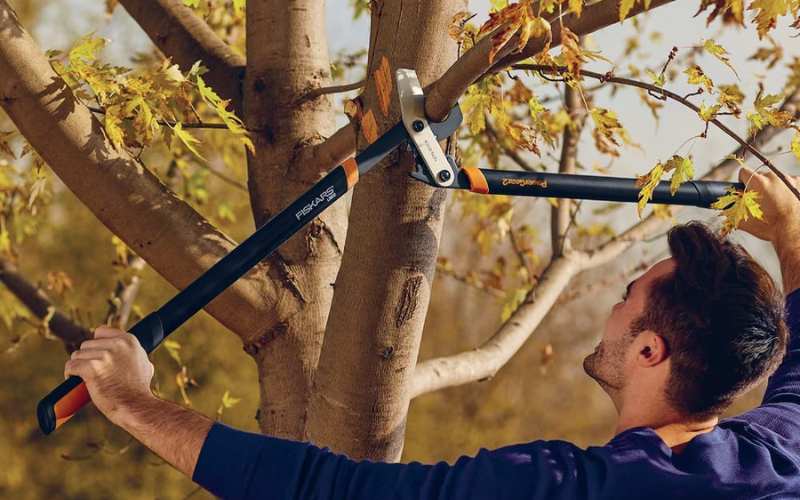
| Tool Specs | |
|---|---|
| Length | 32 inches |
| Cut Capacity | 2 inches |
| Weight | 2.55 lbs |
| Type | Bypass |
With the Fiskars PowerGear2 bypass lopper, you get a premium cutting tool that enables you to cut tree branches up to 2 inches in diameter with slick and smooth cutting action.
Fiskars employ their patented PowerGear technology on it, which multiplies your effort 3 times to make it almost effortless to cut through thick branches and twigs.
It comes equipped with 32-inch handles, which gives you more leverage to reach farther tree branches, and also decreases the effort you need to apply to make the cut.
A fully hardened still blade ensures that the blade doesn’t get dull after a few cuts and can withstand heavy use. The blade is also coated to reduce friction when making cuts to prevent it from rusting.
If you need a good bypass lopper to do some serious pruning in your garden, then the Fiskars PowerGear2 is definitely one you should consider.
The handles are rubberized to ensure a good, soft and comfortable grip during use.
2. AIRAJ Compound Action Anvil Lopper
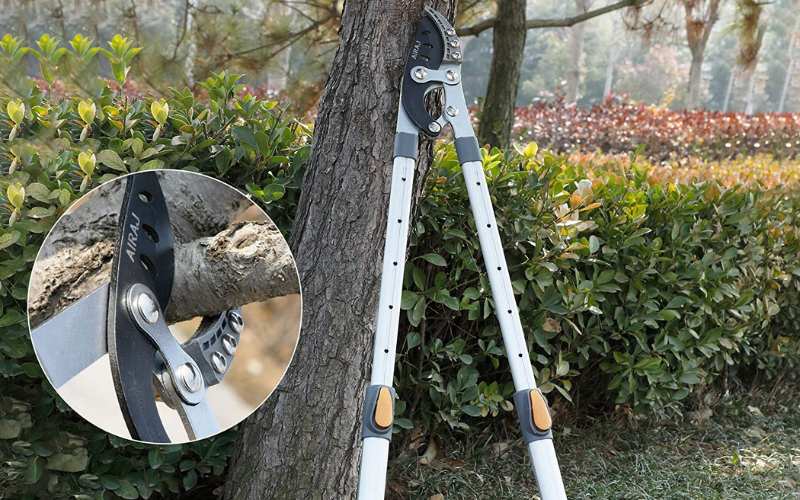
The AIRAJ compound action anvil lopper provides you with the capacity to cut 2-inch branches with ease.
It features a labor-saving lever system with four pivot points that multiply the effort applied on the handles to the blade, thus reducing the amount of force you need to apply to cut down a branch.
Loppers need to have long handles to increase leverage, but with longer handles comes the issue of weight. That’s why this unit from AIRAJ feature high-quality aluminum handles instead of steel to increase reach and reduce weight.
As for the blade, it’s an SK5 hardened alloy steel blade coated with Teflon to prevent rust and corrosion. It stays sharp even after several uses, and if it eventually gets blunt, there’s a spare you can swap in.
The telescoping handles can extend from 27 to 40.5 inches, allowing you to reach tall branches, and they are rubberized for easy grip and comfort during use.
Related: The Best Telescoping Hedge Trimmers
3. Wolf-Garten RR900T
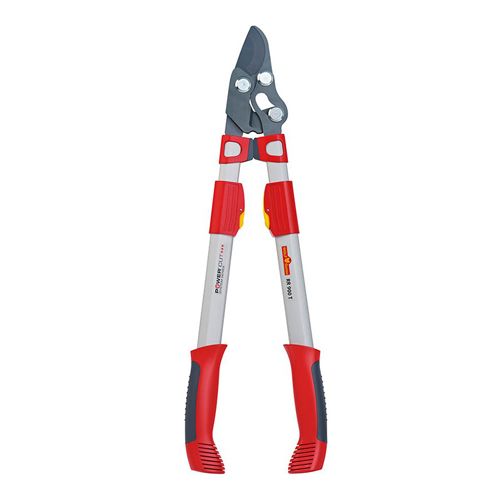
| Tool Specs | |
|---|---|
| Length | 26. 5 ” to 35.6″ |
| Cut Capacity | 1.97 inches |
| Weight | 3.86 lbs |
| Type | Bypass |
If you need a quality German construction bypass lopper, the Wolf-Garten RR900T telescoping bypass lopper will fit your mold of expectation.
It’s made with quality german steel blades that will cut through your tree branches and twigs not more than 2 inches thick, like a hot knife through butter.
The dual-pivot cutting head and the telescoping handles increase reach and ensure it cuts through the branches with minimal effort.
It also means you don’t have to stoop so low when cutting branches or twigs that are way below your reach.
The tool weighs just 3.86 lb which is fairly lightweight when compared to other loppers in its size range.
When it comes to quality, the Wolf-Garten RR900T is definitely not lacking as it’s a German-constructed tool. The blades remain sharp even after heavy use.
Related: The 10 Best Backpack Leaf Blowers for Yard Cleanup
4. Spear & Jackson 8290RS Telescopic Ratchet Anvil Loppers
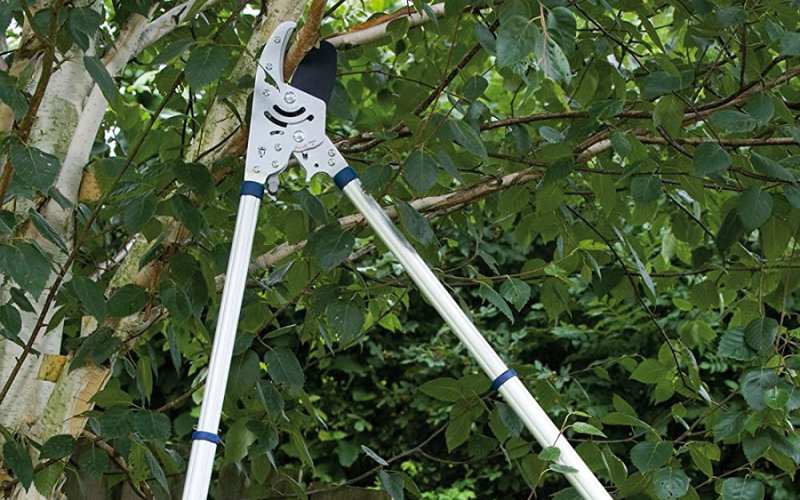
A lopper with a ratchet action blade makes it easier to make cuts, decreasing the effort needed.
That’s why the Spear & Jackson 8290RS telescopic ratchet anvil lopper is one of my favorites. The ratchet action engages when you start cutting, forcing the blade into the branch in a series of short steps, preventing them from going apart until the cut is complete.
It has a cutting capacity of 2 inches, and the telescoping handles extend from 15.75 inches to 31.5 inches to help increase your reach and leverage.
The blade, like a few other loppers is made with SK5 hardened carbon steel alloy and coated to keep it sharp, corrosion, and rust-free.
The serrated anvil prevents the branch from slipping or twisting during a cut.
As for the handles, they’re made of tubular aluminum to keep them as light as possible with all that reach you get, while the soft-grip finish ensures you can hold it comfortably for long periods of pruning.
Related: How To Choose A Lawn Dethatcher
5. Corona DualLink
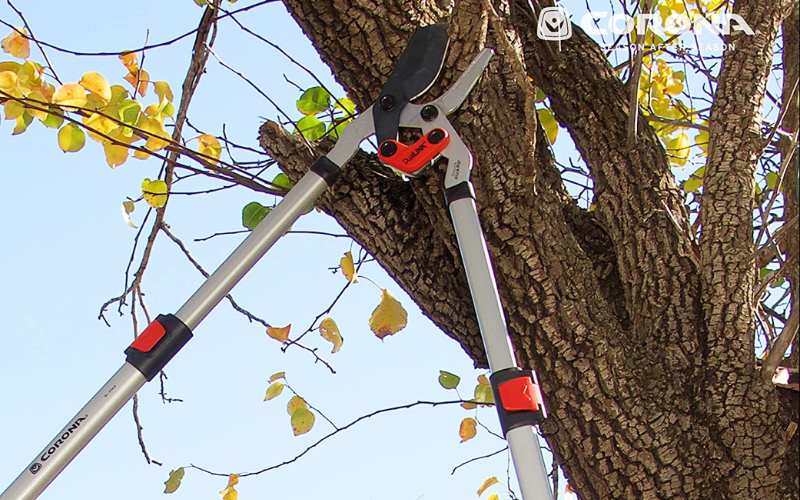
| Tool Specs | |
|---|---|
| Length | 27 1/2″ to 37 1/2″ |
| Cut Capacity | 1 3/4″ |
| Weight | 4.15 lbs |
| Blade Type | Bypass |
The Corona DualLink Bypass Lopper gives you the capacity to cut through limbs as small as 3/4 inches in size and as large as 1 inch in size.
With its extendable or telescoping arms feature, you get to be able to reach far higher branches without overreaching. Just flip open the red lever on the handles to release the telescoping handles and extend them, and flip back to lock down the handles, and you can start using it.
Without extending the handles, they are 27 ½ inches in length, but after extending them, you get a length of 37 ½ inches. That is an extra 10-inch increase in length, affording you more leverage to reach more limbs and branches from your position.
The Corona DualLink features a ShockGuard bumper system which helps reduce the snapping action of the jaws after cutting to reduce user fatigue.
This unit is surely one of the best to go for if you’re looking for something that can afford you more leverage when pruning your tree branches.
Related: 32 Essential Gardening Tools You Should Know
6. Jardineer
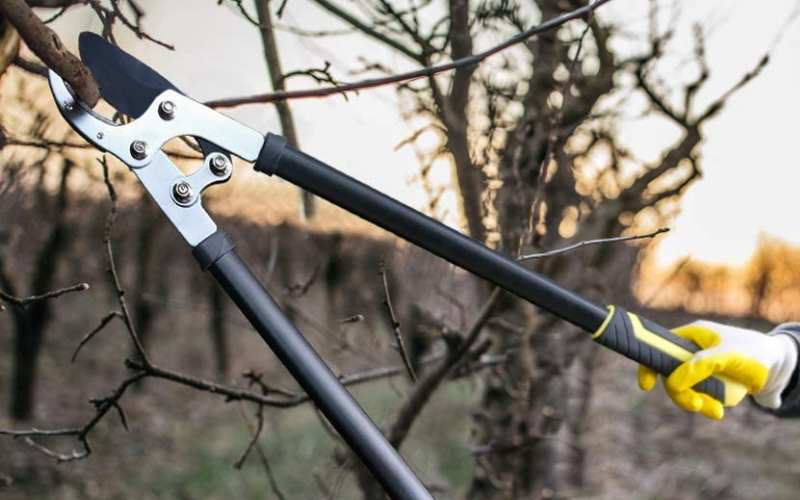
With 30-inch long handles, the Jardineer Anvil lopper gives enough leverage to prune branches as wide as 2 inches.
It’s a heavy-duty tool that is well-built and designed to make your tree-pruning projects go as smoothly as possible.
Apart from the leverage, it also comes equipped with a heavy-duty ratchet jaw that will maximize every force applied to the handles to make cutting through thick branches a breeze.
The handles are made with solid steel to ensure they stand the test of time and are also paired with soft grip holders to ensure user comfort during operation.
You should know, however, that it is a light-duty lopper for branches 2 inches and below, nothing more. So, keep that in mind if you’re going for it.
You can use it for sniping light stems, pruning twigs, fruit trees, and other landscaping projects.
It comes equipped with a non-stick carbon steel blade to preserve plant, and also to preserve the sharpness of the blade even after several cuts.
The Jardineer anvil lopper even comes with a spare blade you can swap in if the first one gets blunt, thus helping you get more work out of the tool before spending money on another lopper or another blade.

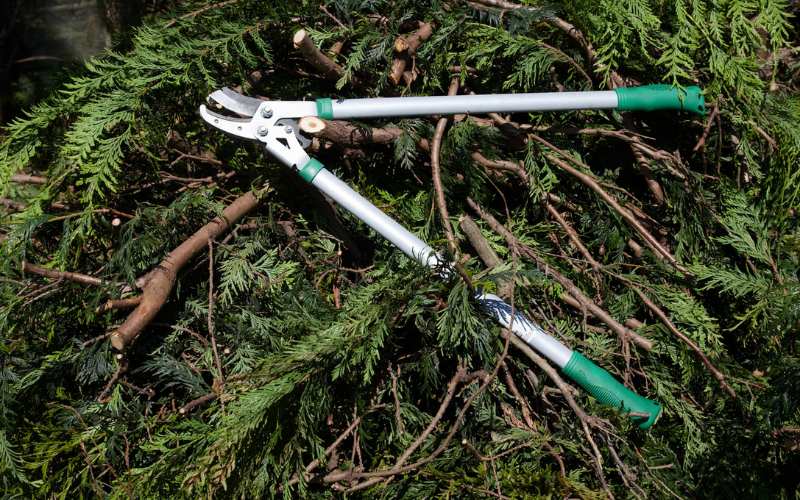



Broke my Green Thumb 2060BGT Bypass Loppers yesterday. Can’t find a replacement. Are they available anywhere?